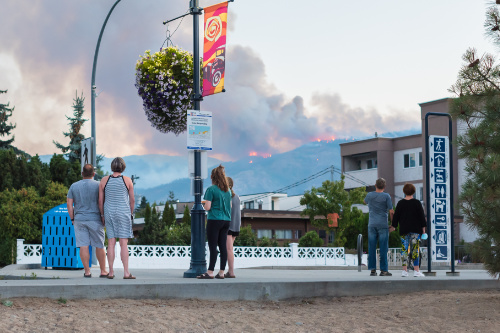
FireSmart is the number-one mitigation program for wildfire in Canada. It’s a set of guidelines for people who live and work near the Wildland Urban Interface – the area where homes and businesses meet forests and grasslands and that are prone to wildfire. FireSmart guidelines reduce the probability of home ignition and wildfire losses. Home survival is not necessarily random or a matter of luck.
FireSmart guidelines were introduced in 2003 in Canada. In May 2016 a wildfire swept through Fort McMurray, Alberta, destroying 2,479 dwellings and 22 commercial spaces and causing more than 90,000 people to evacuate. Afterward, the Institute for Catastrophic Loss Reduction investigated the circumstances regarding the survival or destruction of homes and published its findings in Why Some Homes Survived: Learning from the Fort McMurray Wildfire Disaster. In all neighbourhoods studied, homes whose owners had adopted FireSmart guidelines survived much more frequently than homes where they had not, despite the extraordinarily harsh conditions.
The devastating power of embers
The Fort McMurray and subsequent wildfires have demonstrated the degree to which embers are a driving force in the spread of wildfire. It is commonly estimated that half of the home fires attributed to wildfire are ignited by embers; a 2019 insurance study in the U.S. found that embers alone accounted for 90% of all homes and buildings that ignited in a wildfire. Carried by the wind, embers on average travel as far as two kilometres before falling, still capable of instantly igniting the right fuel. There have also been documented instances of embers travelling 17 km. For a sobering illustration on how embers spread fire, go to https://firesmartbc.ca/why-we-focus-on-embers.
An ember that lands on or near a fire-resilient home/yard will typically burn out before it can ignite a roof or wall. However, if the same ember lands on a fuel source of any sort, it can ignite. FireSmart practices come down to a single purpose: keeping any and all potential sources of fuel away from – and off of – the structure.
A shared responsibility
Building fire resiliency doesn’t take a lot of complex work; FireSmarting is surprisingly simple and straightforward. When every member of a community performs their FireSmart-proven chores (cutting the grass, cleaning gutters, etc.), it goes a long way in terms of increasing fire resiliency.
To increase the fire resiliency of your home and your community, take these proactive steps:
Your home and immediate surrounds
- A minimum 1.5-metre non-combustible surface should extend around the entire home.
- Roof material should be fire-resistant or fire-retardant, referred to as Class A, B, or C rated roofing. Keep your roof and eavestroughs clear of combustible materials. A spark arrestor on your chimney will reduce the chance of sparks and embers escaping.
- Properly fitted soffits and fascia help reduce the risk of embers and heat reaching the wooden rafters of your home.
- Fire-resistant exterior finishes include stucco, metal siding, brick/concrete, and fibre cement siding (for ex., Hardie products). Untreated wood and vinyl siding offer very little protection against wildfire.
- Tempered, thermal (double-paned) windows are recommended. Single-pane windows provide little resistance to heat from an advancing wildfire.
- All doors should be fire-rated and have a good seal. This is true for your garage doors as well as your entry doors.
- Sheath in the base of the decks, balconies, and houses with fire-resistant material to reduce the risk of sparks and embers igniting your home.
- Sheds and outbuildings within 10 metres of your home should be given the same FireSmart considerations as your home.
Up to 10 metres around your home
Maintain a zone that’s free of all materials that could easily ignite from a wildfire. Spacing trees at least three metres apart will help reduce the intensity of a wildfire. Prune all tree branches within two metres of the ground.
- Plant low-density, fire-resistant plants and shrubs. Avoid having any woody debris present, including mulch, since it can provide places for fires to start.
- A mowed lawn is a fire-resistant lawn. Keep your lawn under 10 centimetres tall.
- Wood piled against a house is a major fire hazard. Moving your firewood pile may be a key factor that allows your home to survive a wildfire. Clean up any such areas regularly, since easily ignited debris often collects here.
- Burn barrels should be placed as far as possible from structures and trees.
- Every home should have readily accessible shovels, rakes, axes, garden hoses, sprinklers, and ladders to assist in suppressing wildfires.
- Power lines should be clear of branches and other vegetation. Contact your local utility company to discuss removing any branches or vegetation around overhead electrical installations.
Every resident, in every type of dwelling, can do their part to increase the fire resiliency of their community by FireSmarting their property and encouraging others to do the same.
Beyond 10 metres
- Space coniferous trees about three metres apart and prune or remove smaller trees and other potentially flammable vegetation. Regularly clean up accumulations of fallen branches, dry grass, and needles to eliminate potential surface fuels.
Many of these tasks are simple everyday chores that you can check off your list with a free weekend, a few tools, and some elbow grease. Wildfire resiliency and loss prevention are individual and community efforts. The more we all chip in by doing our everyday chores, the more fire-resilient our homes, communities, and province will be.
To learn more and to download resources, visit FireSmart BC. You’ll find resources for assessing your property’s preparedness for wildfire, and for sharing with neighbours. Additional resources to help you stay safe and recover quickly after a loss: Rebound, provided by the insurance brokers of B.C., and the many guides available from Prepared BC.




Reliance Insurance proudly serves
Burnaby and the Vancouver area